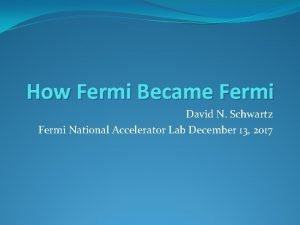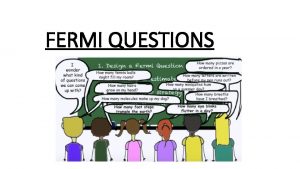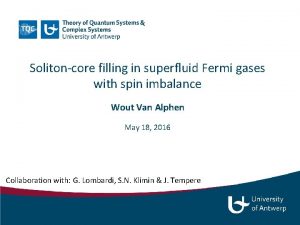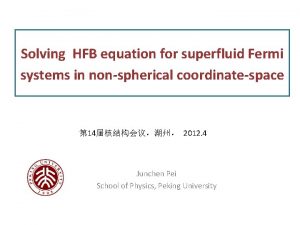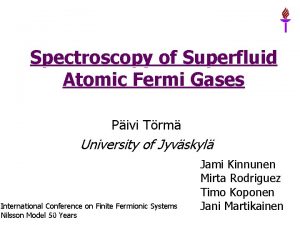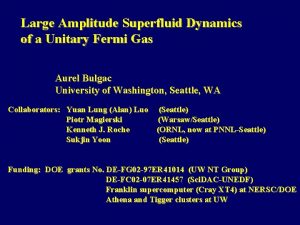QUASIPARTICLES IN NORMAL AND SUPERFLUID FERMI LIQUIDS more











- Slides: 11

QUASIPARTICLES IN NORMAL AND SUPERFLUID FERMI LIQUIDS (more questions than answers …) Tony Leggett Department of Physics University of Illinois Urbana-Champaign The David Pines Symposium on Superconductivity Today and Tomorrow Urbana, IL 30 March 2019

DP-1 QUASIPARTICLES IN NORMAL PHASE Landau (1956), Nozières, Theory of Interacting Fermi Systems (1964): ( Luttinger theorem trivial) Suppose then in original noninteracting system Is it true that in fully interacting system also

DP-2 yes total number yes total spin yes total current no total spin current (etc. ) (b) metallic system (e. g. cuprates)

Consequences of conservation for response functions DP-3 zero-sound peak

DP-4 Moral: Even if system is a “decent” Fermi liquid, correlation function of non-conserved quantity can have large contribution from incoherent background. Application to cuprates (and maybe other SCES): Are the optimally doped and underdoped cuprates “bad” Fermi liquids? (cf. e. g. Berthod et al. , PR B 87, 115109 (2013)).

QUASIPARTICLES IN THE SUPERFLUID STATE DP-5 1. Andreev reflection e. g. : > ? energy relative to Fermi energy Is there direct experimental evidence for this? Yes! frictional force due to reflection of qps (S-K Yip and AJL, PRL 57, 345 (1986))

DP-6 2. The “Zeeman-dimple” problem Andreev reflection What is nature of lowest-energy odd-parity state? Answer: Single Bogoliubov quasiparticle trapped in “dimple”. Extra spin localized in/close to dimple = 1. *Y. -R. Lin and AJL, JETP 119, 1034 (2014)

DP-7 What is extra charge? particle hole In quasiclassical approximation with only Andreev reflection: but in formula extra charge = 0

DP-8 Further complication: in this approximation, ground state of odd-number-parity sector is doublet related by time reversal! particle hole particle “Normal” (non-Andreev) reflection splits doublet into even and odd combinations with exponentially small splitting. However, this does not change situation with regard to C-symmetry. zero extra charge is not robust. (even in quasiclassical approximation)

DP-9 3. Effect of taking particle number conservation seriously With assumption of SBU(1)S or more generally (BDG) spontaneously broken U(1) symmetry Bogoliubov-de Gennes This does not conserve particle number. Remedy: creates extra Cooper Pair Question 1: Is the “extra” pair the same as those in the evenparity GS? Question 2: Irrespective of answer to 1, does it matter?

DP-10 Conjecture: for “usual” case (e. g. Zeeman-dimple problem), effect is nonzero but probably small. but for case where Cooper pairs have “interesting” properties (e. g. intrinsic angular momentum) effect may be qualitative. The crunch case: Majorana fermions in (p+ip) Fermi superfluid (Sr 2 Ru. O 4? ): does extra Cooper pair change results of “standard theory (e. g. Ivanov 2001) qualitatively? -the $64 K (actually $6. 4 M!) question…
 More more more i want more more more more we praise you
More more more i want more more more more we praise you More more more i want more more more more we praise you
More more more i want more more more more we praise you Superfluid example
Superfluid example Human history becomes more and more a race
Human history becomes more and more a race 5 apples in a basket riddle
5 apples in a basket riddle The more you study the more you learn
The more you study the more you learn Aspire not to have more but to be more
Aspire not to have more but to be more More inertia
More inertia Knowing more remembering more
Knowing more remembering more The more i give to thee the more i have
The more i give to thee the more i have More choices more chances
More choices more chances Expansion of solids liquids and gases examples
Expansion of solids liquids and gases examples












